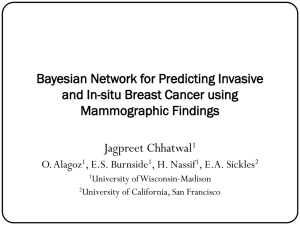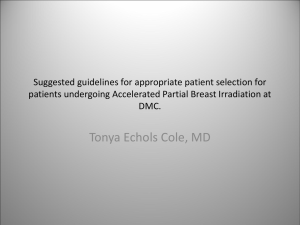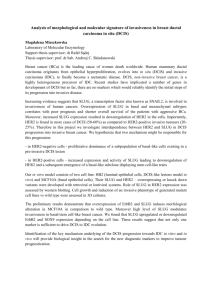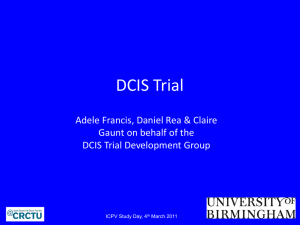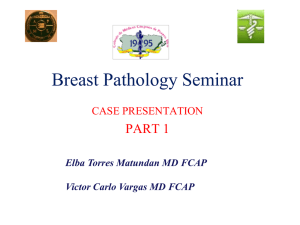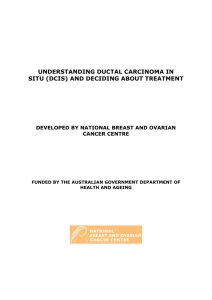Age Stratified Risk Prediction of Invasive versus In
advertisement
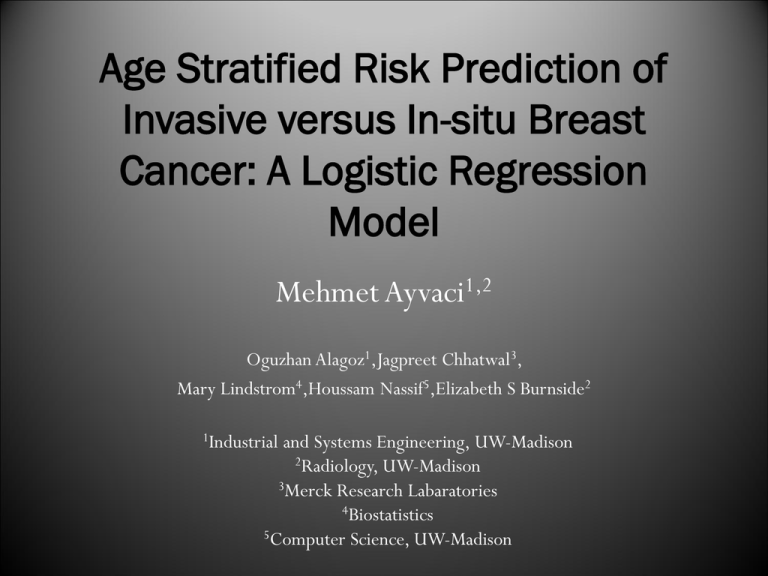
Age Stratified Risk Prediction of Invasive versus In-situ Breast Cancer: A Logistic Regression Model Mehmet Ayvaci1,2 Oguzhan Alagoz1,Jagpreet Chhatwal3, Mary Lindstrom4,Houssam Nassif5,Elizabeth S Burnside2 1Industrial and Systems Engineering, UW-Madison 2Radiology, UW-Madison 3Merck Research Labaratories 4Biostatistics 5Computer Science, UW-Madison Breast Anatomy Breast profile: – A ducts – B lobules – C dilated section of duct to hold milk – D nipple – E fat – F pectoralis major muscle – G chest wall/rib cage • Enlargement: – A normal duct cells – B basement membrane – C lumen (center of duct) www.breastcancer.org Progression of Breast Cancer Atypical ductal hyperplasia Normal duct Typical ductal hyperplasia Invasive ductal carcinoma Ductal carcinoma in situ (DCIS) Age Stratified Risk Prediction of Invasive vs In-situ Breast Cancer: A Logistic Regression Model Age Stratification for Invasive vs In-situ Breast Cancer • Primary modality of screening or diagnosis: Mammography • Performs differently in different age groups • Sensitivity: Age – <40 54% – 40-49 77% – 50-65 78% – >65 81% • Sensitivity: Breast Density – 68% vs. 85% – Younger vs. older Age Stratification for Invasive vs In-situ Breast Cancer • Primary modality of detecting type of breast cancer: Biopsy • Incidence of DCIS has increased since adoption of mammography • DCIS has favorable prognosis: will often not cause mortality for years • PPV of biopsy 20% Age Stratification for Invasive vs In-situ Breast Cancer • Invasive vs. DCIS distinction important because: • Requires different treatment • Life expectancy difference in older and younger women – Over diagnosis which does not correspond to reduced mortality – Breast cancer less aggressive in older women – Invasive procedures more risky in older women – Resources could be better spent on more serious co-morbidities Purpose and Methods • Develop a risk prediction model for prospective differentiation of DCIS versus invasive breast cancer • Measure and compare model performance for different age groups LOGISTIC REGRESSION 1 N 1 e ( i X i ) ROC Curves i 1 Purpose and Methods Contd. Risk Assessment Tools Clinical Implications ROC & PR Curves, Statistical Testing Markov Decision Processes Clinical Implications Structure of Data Used NMD National Mammography Database Format Structured Demographic Factors Mammographic Descriptors BIRADS descriptors Radiologists’ Overall Assessment of the Mammogram with Some Repeat to the Structured Part Free Text Turned into Structured format using Natural Language Processing Methods: Processing Free Text • Information retrieval from free text given a standardized lexicon • Parse sentences to detect BIRADS descriptors using Natural Language Processing in PERL • Test on a set of 100 which is manually populated – 97.7% Precision – 95.5% Recall Data in Detail Structured DEMOGRAPHIC Age Family History Personal History Prior Surgery Palpable Lump Interpreting Radiologist Breast Density Indication for Exam if Diagnostic Associated Findings Free Text Calcification Distribution Calcification Morphology == Features Extracted Using NLP Mass Margins Mass Shape Mass Density Mass Size Special Cases Biopsy MAMMOGRAPHIC BI-RADS Assessment Principle Abnormal Finding o Architectural Distortion o Calcifications o Asymmetry (one view) o Focal asymmetry (two views) o Developing asymmetry o Mass o Single Dilated Duct o Both Calcifications and Something Else Skin Retraction, Nipple Retraction, Skin Thickening, Trabecular Thickening, Skin Lesion, Axillary Adenopathy, Architectural Distortion Clustered, Linear, Regional, Scattered, Segmental, Diffuse Pleomorphic , Dystrophic, Lucent, Punctate, Vascular, Eggshell, Dermal, Fine-Linear, Round, Popcorn, Milk of Calcium, Rod Like, Suture, Amorphous, Circumscribed, Obscured, Defined, Microlobulated, Spiculated Irregular, Lobular, Oval, Round Fat Containing, Low Density, Equal Density, High Density <10mm, >10mm and <20mm, >20mm and<50mm, >50mm Intra-mammary Lymph Node, Tubular Density, Assymetric Breast Tissue, Focal Asymmetric Density Insitu, Invasive Summary of Data • 1475 Diagnostic Mammograms 1378 Patients – 1298 patients with single mammogram – 81 patients with 2 mammograms – 5 patients with three mammograms • 1063 cases invasive vs. 412 DCIS • Age range 27 to 97 with – Mean 59.7 and standard deviation 13.4 Methods: Performing Logistic Regression • Regress with a dichotomous outcome, where the patient is known to have malignant condition, i.e. – Invasive or – DCIS P(Invasive|Demographic Factors, Mammographic Descriptors) • Stratified data into 3 groups – Overall Model LR 1475 records – Age Less Than 50 LRyoung 374 records – Age Greater Than 65 LROld 533 records • Used stepwise regression to find the appropriate models. Possibility of interactions were investigated Methods: Validation Technique n fold cross-validation Leave-one-out Fold Data set 1 2 3 … n … Test fold Training fold Merge tested folds for performance analysis Fold 1 2 3 … n Methods: Measuring Performance Sensitivity vs. 1-Specificity at all thresholds – Sensitivity: True Positive Rate – Specificity: True Negative Rate – Thresholds: Probability above which call “Invasive” – AUC: Area Under the Curve Patient with Disease Patients without disease Test + a b Test - c d Sensitivity=a/(a+c) Specificity = d/(b+d) Results: LR Age Based Error Rates 35.00% 30.00% ROC 32.58% 100.00% 30.00% 90.00% 25.00% 20.00% 22.73% 22.35% 19.70% 17.64% 17.61% 15.58% 15.00% 12.72% Sensitivity (TPR) 80.00% 70.00% 60.00% AUC 0.843 50.00% 40.00% 30.00% 20.00% 10.00% 10.00% 0.00% 0.00% 5.00% 0.00% AgeLT50 Age5064 FPR FNR AgeGTE65 Total Error Rate Row Labels Subject Count Actual Invasive Count AgeLT50 Age5064 AgeGTE65 Overall 374 568 533 1475 264 398 401 1063 20.00% 40.00% 60.00% 1-Specifity (FPR) 80.00% 100.00% • Overall model significant at pvalue<0.01 • Not enough power to justify inclusion of interaction terms (Over-fitting) • Acceptable ROC • Decreasing trend in Error rates Results: LRyoung vs. LRold Risk Factor Significant in Both Models Significant in Only Young Younger Odds P-Value Palpable Lump >1 0.01 >1 <0.001 Mass Shape ~>1 0.03 ~>1 0.03 Principal Finding >1 <0.001 >1 <0.001 Architectural Distortion >1 0.06 Varies 0.05 Varies 0.04 Calcification Distribution <1 0.01 Focal Asymmetry >1 0.08 Prior Surgery >1 0.13 Mass Size Family History Significant in Only Old Older Odds P-Value Results: LRyoung vs. LRold • Difference in AUC = 0.07 • Significant at p-value = 0.045 ROC Older vs. Younger 100.00% 90.00% 80.00% Sensitivity 70.00% 60.00% 50.00% 40.00% 30.00% 20.00% 10.00% 0.00% 0.00% 20.00% 40.00% 60.00% 1-Specifity 80.00% Age LT 50 AUC:0.778 Age GTE 65 AUC:0.848 100.00% Results: LRyoung vs. LRold • Improvement is in False Negatives False Rate Over Threshold 100.00% 90.00% 80.00% 70.00% Rate 60.00% 50.00% 40.00% 30.00% 20.00% 10.00% 0.00% 0 0.1 0.2 0.3 0.4 0.5 0.6 0.7 Threshold FNR Age GTE65 FPR Age LT50 FNR Age LT50 FPR Age GTE65 0.8 0.9 1 In Summary • Mammography is not perfect and performs better in older women. • There is a need for discriminating between invasive and DCIS to better manage the breast disease in the context of age and other comorbidities • An age based risk prediction model for assessing performance difference in discriminating invasive vs. DCIS is necessary • Such a model would enable physicians to make more informed decisions • Demonstration of performance difference and varying risk factors in different age cohorts justifies Future Work Risk Assessment Tools ROC & PR Curves, Statistical Testing Markov Decision Processes Clinical Implications Get in Literature Clinical Implications Using POMDPs to Determine the Optimal Mammography Screening Schedule From the Patient's Perspective Presenting Author: Turgay Ayer,University of Wisconsin Co-Author: Oguzhan Alagoz,Assistant Professor, University of Wisconsin-Madison Questions? THANK YOU!
